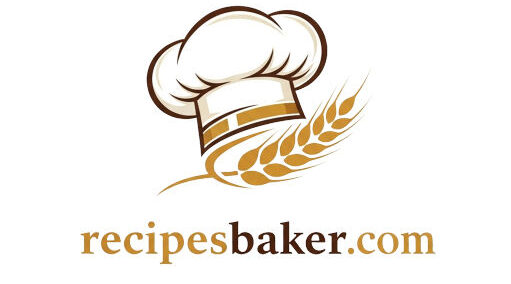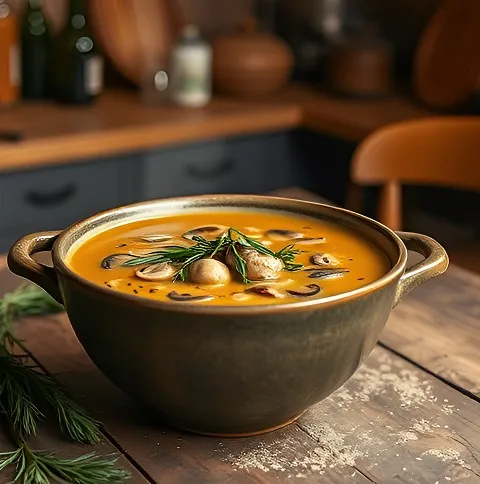When the days start to get a little shorter and the air turns crisp, nothing brings warmth and comfort quite like a bowl of golden mushroom soup. There’s something almost magical about a soup that marries the earthy flavors of mushrooms with a creamy, velvety base—almost like a hug served in a bowl. In this guide, we’re going to dive deep into everything you need to know about crafting the perfect golden mushroom soup. From gathering your ingredients and preparing the mushrooms to exploring creative twists and nutritional benefits, this article covers it all. So, whether you’re a seasoned home cook or new to the art of soup-making, read on and discover how this classic dish can become your next favorite comfort food.
Table of Contents
Discovering the Magic of Golden Mushroom Soup
What Is Golden Mushroom Soup?
Golden mushroom soup is far more than just another recipe in your cookbook; it’s an experience. At its core, this soup is a celebration of mushrooms—those delightful, earthy ingredients—and a creamy broth that transforms simple produce into a luxurious dish. The term “golden” not only refers to its appealing hue—a result of butter, careful sautéing, or even the natural color of some mushroom varieties—but also to the rich, layered flavor profile that makes every spoonful a delight.
When you take that first sip, you notice how the mushrooms impart a deep, almost nutty taste, complemented by a creamy texture that coats your palate. There is a subtle balance between the savoriness of a well-made broth and the freshness of herbs, showcasing both simplicity and culinary finesse in one bowl. This blend of flavors creates a dish that can transport you back to cozy family dinners and quiet evenings by the fire.
Why This Soup Has Earned a Special Place in Kitchens Everywhere
The secret behind the enduring popularity of golden mushroom soup lies in its versatility and ease of preparation. The recipe doesn’t require a pantry full of exotic ingredients or hours of complicated prep work. Instead, it calls for well-chosen basics—good quality mushrooms, savory stock, creamy dairy (or plant-based alternatives), and just the right blend of aromatics like garlic and onions. The result is a dish that feels both luxuriously indulgent and comfortingly familiar.
Many home cooks are drawn to golden mushroom soup because it offers a canvas for creativity. While the traditional version is divine on its own, there’s plenty of room to experiment. Whether you decide to add a splash of wine for an extra complexity or toss in a handful of fresh herbs, the soup adapts wonderfully to your personal taste. This blend of ease and versatility means that golden mushroom soup is not only a staple in many households but also a dish that evolves with every new twist you try.
A Brief History and Evolution of Creamy Mushroom Soups
Creamy soups have been a beloved part of culinary traditions for centuries, and mushrooms have long held a revered place in the world of gastronomy. Historical records reveal that the practice of combining mushrooms with cream dates back to several cultures where foraging was both a necessity and an art form. Over time, as kitchens modernized and available ingredients evolved, so did the soup.
Today’s golden mushroom soup is an offshoot of those early, simple recipes. Its evolution is a testament to how classic recipes can be reinvented through small, thoughtful adjustments in technique and ingredients. While some chefs may add unique garnishes or regional spices, the soul of the dish remains a celebration of what mushrooms and cream can create together—a dish that brings warmth, nostalgia, and a burst of flavor with every bite.
Gathering the Essentials: Ingredients for Your Golden Creation
The Core Ingredients and Their Role
Before you even turn on your stove, the journey to an exceptional bowl of golden mushroom soup begins with choosing the best ingredients. The star of the show, of course, is the mushroom. Look for fresh, firm mushrooms that promise a robust flavor and appealing texture when cooked. Aside from mushrooms, you’ll need a high-quality broth or stock to form the regenerative liquid base of the soup. For the creamy element, options like heavy cream, whole milk, or plant-based alternatives give you a range of textures and nutritional values to consider.
A good soup never shies away from its aromatics—onions and garlic are non-negotiable. Sautéed properly, these ingredients not only infuse the soup with a wonderful scent but also create a flavor foundation that elevates everything that follows. A touch of flour is essential too; it forms a roux when combined with butter or oil, lending the soup a smooth, thick consistency. And lastly, a dash of salt, pepper, and your choice of herbs helps tie all the flavors together.
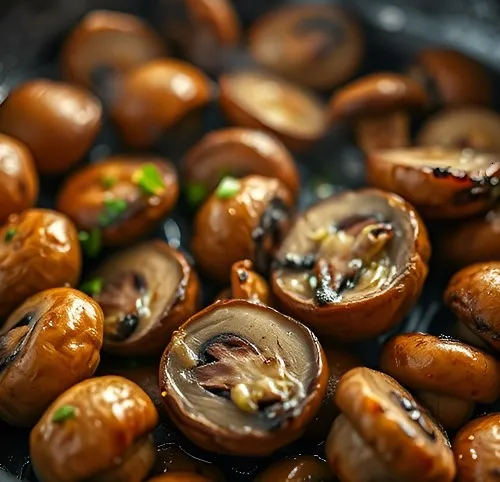
Choosing Your Mushrooms Wisely
Mushrooms come in many shapes, sizes, and flavors. While classic white button mushrooms lend a mild taste and a familiar texture, don’t hesitate to mix in other varieties. Cremini mushrooms, with their deeper earthy notes, can provide a more complex flavor profile. If you’re on a culinary adventure, consider adding shiitake or oyster mushrooms for an extra layer of taste that stands out. Using a combination of these mycological wonders can bring an exciting mix of textures and flavors to your soup, ensuring that every bite is both interesting and satisfying.
Stock, Broth, or Bouillon: Setting the Foundation
The liquid you choose is as pivotal as the solid ingredients. A robust chicken or vegetable broth sets the tone for the entire dish, contributing a subtle background flavor that complements the mushrooms perfectly. If time allows, consider making your broth at home. Not only does this add a personal touch, but it also means you have complete control over the seasoning and nutritional content of your soup. The key is to use a broth that is rich in flavor yet balanced—this way, it won’t overpower the delicate earthiness of the mushrooms.
The Dairy Dilemma: Cream, Milk, and Alternatives
Achieving that signature creamy texture in golden mushroom soup is all about your choice in dairy products. Heavy cream produces an indulgently rich consistency, while a lighter alternative like whole milk offers a less velvety texture but cuts back on calories. For those steering clear of dairy, modern kitchen pantries are filled with plant-based milks—oat, almond, or cashew milk can all be brilliant substitutes that maintain creaminess while accommodating dietary restrictions. Whichever option you choose, remember that this component is vital to achieving the smooth, luscious texture that defines golden mushroom soup.
The Step-by-Step Journey to a Perfect Bowl
Preparing the Mushrooms: Cleaning and Slicing Techniques
Once you’ve gathered your ingredients, the first practical step is to treat your mushrooms with the respect they deserve. Instead of rinsing them under a running tap—which can make them waterlogged—gently brush or wipe them clean with a damp cloth. This method keeps their texture intact while removing any dirt. After cleaning, carefully slice the mushrooms. Aim for slices that are about ¼ inch thick. This thickness ensures that while they cook evenly, they also retain enough bite to remain interesting in texture. It might seem like a small detail, but it makes a big difference in the end result.
Sautéing Aromatics: Creating a Flavorful Base
Now that your mushrooms are prepped, it’s time to build the flavor foundation. Heat a generous knob of butter or a splash of olive oil in a large pot over medium heat. Start by adding finely chopped onions, letting them soften until they turn translucent and begin to release their natural sweetness. Once the onions are ready, toss in minced garlic. The sizzling sound of garlic hitting the pan is often the first hint that something delicious is coming together. Allow the garlic to cook for about a minute until its fragrance fills your kitchen, setting the stage for the mushrooms to absorb every note of this aromatic blend.
Cooking the Mushrooms: Releasing the Essence
With your aromatics perfectly sautéed, gently introduce the sliced mushrooms into the pot. At first, you’ll notice that they release a burst of moisture—this is completely normal. The trick here is to let the mushrooms simmer until that extra liquid evaporates and the slices begin to develop a golden-brown edge. The browning process is key; it unlocks their natural caramelized sugars, resulting in a depth of flavor that forms the backbone of your soup. Patience is essential in this step; resist the urge to rush it. Give the mushrooms the time they need to transform fully into their best self.
Crafting the Roux: The Secret Behind Silky Creaminess
One of the most important techniques in making a truly exceptional golden mushroom soup is the formation of a roux. Once your mushrooms have browned, sprinkle a measured amount of flour over them. Stir constantly to combine the flour with the mushroom-infused butter or oil, creating a paste that will eventually thicken your soup. Cook this mixture for about one to two minutes to eliminate any raw flour taste while ensuring the roux gains a subtle toasty aroma. This step not only adds body and structure to your soup but also helps integrate all the flavors in a smooth, cohesive way.
Integrating the Broth and Simmering to Perfection
After your roux has reached its golden stage, it’s time to incorporate the broth. Do this slowly, adding a little bit at a time while stirring constantly to avoid any lumps. As the liquid and roux come together, you’ll notice the base starting to thicken into the perfect consistency for a hearty soup. Bring the mixture to a gentle simmer and let it cook for at least 15 to 20 minutes. This simmering period allows the flavors to meld and develop beautifully, transforming the medley of ingredients into a unified, rich broth that serves as the soul of your golden mushroom soup.
Blending Versus Leaving It Chunky: Your Personal Touch
At this stage, you’re presented with a delightful choice: should your soup be velvety smooth or remain with satisfying chunks of mushroom? An immersion blender is a handy tool if you prefer a silky texture that feels like a dream on the tongue. Simply blend portions directly in the pot, always being cautious with hot liquids. Alternatively, if you love the rustic charm of visible mushrooms and bits of herbs, you can leave the soup as is. Both choices have their merits, and the decision ultimately rests on your mood and texture preferences.
Finishing Touches: Seasoning and Cream Integration
With your base now complete, it’s time to incorporate the final components that lift the golden mushroom soup off the page. Slowly stir in your choice of cream, milk, or a non-dairy alternative. Warm the mixture gently; it’s important not to let it come to a full boil at this stage, as that might break the smooth consistency you’ve worked so hard to achieve. Now, taste test your creation. Add a pinch or two of salt and pepper, and if you fancy, a sprinkle of fresh herbs like thyme or parsley to brighten the flavors. This is your moment to play chef—adjust the seasonings until the soup sings in perfect harmony with your taste buds.
Elevating Your Golden Mushroom Soup: Advanced Tips & Tricks
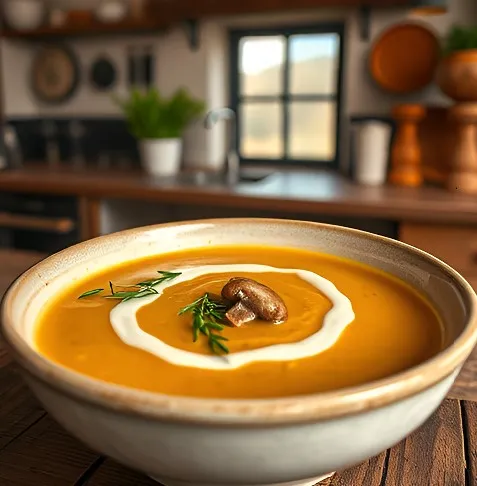
Adding a Splash of or Sherry for Depth
If you’re looking to add an extra layer of sophistication to your golden mushroom soup, consider deglazing your pan with a splash of dry white wine or sherry once the mushrooms have browned nicely. This technique not only lifts the caramelized bits stuck to your pot’s bottom but also infuses the soup with a subtle tang and complex flavor that enhances the earthy notes of the mushrooms. Just a tablespoon or two can transform the taste profile, turning a humble soup into a restaurant-worthy dish.
The Role of Herbs: Fresh Versus Dried
Herbs are a secret weapon when it comes to seasoning your soup. Fresh herbs, such as chopped thyme or parsley, added near the end of cooking, can imbue your soup with a bright, aromatic finish. On the other hand, dried herbs like bay leaves or dried thyme when added early in the simmering process work to imbue the broth with a consistent, underlying herbal note. Experimenting with combinations of both fresh and dried herbs can yield a nuanced flavor that dances on the palate. Always remember to remove any large pieces like bay leaves before serving.
The Art of Sautéing: Ensuring Maximum Flavor Extraction
A common pitfall during the preparation of any mushroom dish is overcrowding the pan. When too many mushrooms are added at once, they tend to steam rather than brown, which can result in a lackluster flavor. To avoid this, work in batches if necessary. This extra step ensures that each slice of mushroom gets the full benefit of caramelization, which is essential for a deep, robust flavor in your soup. Taking the time to sauté properly is one of the simplest ways to elevate your dish from good to extraordinary.
Troubleshooting Thickness and Consistency
Even seasoned cooks sometimes run into texture troubles. If your soup ends up feeling too thick, simply thin it out with a little more broth or water. Conversely, if it seems too watery, let it simmer a bit longer, or blend in a small slurry of flour and water to help it thicken. Taste, adjust, and have confidence in your ability to perfect the consistency. Each batch is a learning experience, and these adjustments can help you dial in the exact texture you’re aiming for.
Exploring Creative Variations: Tailoring the Soup to Your Taste
Experimenting with Wild Mushrooms
For those nights when you feel especially adventurous, try exploring the world of wild mushrooms. Varieties such as chanterelles, porcini, or even morels bring a wild, nutty, and sometimes slightly smoky flavor that dramatically elevates the dish. Wild mushrooms can be more delicate, so blend them with robust house mushrooms like cremini to maintain both balance and depth in flavor. This variation is ideal for a special dinner or whenever you want your soup to feel uniquely gourmet.
Enriching Your Soup with Protein
Golden mushroom soup can be a meal in itself, but if you’re after something heartier, adding protein is a great option. Shredded rotisserie chicken, browned sausage slices, or even cubes of firm tofu can transform your soup into a more filling entrée. If you’re opting for sausage, prepare it separately to ensure it browns nicely before mixing it into the soup. These additions not only make the dish more robust but also allow you to experiment with contrasting textures and flavors that complement the creamy base perfectly.
Adapting the Recipe for Vegan and Dairy-Free Lifestyles
Today’s food culture embraces inclusivity, and that means your golden mushroom soup can be just as delightful in a vegan or dairy-free version. Swap out the butter for olive oil or vegan butter, and use plant-based milk or cream—such as oat, almond, or cashew milk—in place of the traditional heavy cream. Nutritional yeast can be stirred in toward the end of cooking to provide a subtle cheesy flavor without any dairy. With these simple substitutions, you maintain the integrity of the dish while making it accessible to a wider audience.
Adding a Spicy Kick
If you’re someone who likes a bit of heat with their comfort foods, consider incorporating red pepper flakes, a dash of hot sauce, or even a roasted poblano pepper into your soup. Begin with a small amount during the initial sauté of your aromatics and adjust as needed toward the end of cooking. The peppery spice layers with the rich creaminess, creating a delightful contrast that can awaken your taste buds and add an unexpected twist.
Infusing with Different Cheeses
Cheese lovers need not look far, as a slight variation can involve adding shredded cheese for an even more decadent result. A handful of grated Parmesan, a sprinkle of Gruyère, or even a dollop of cream cheese melted into the warm soup can transform the flavor and texture. When using cheese, be sure to add it after the heat has been lowered so it melts smoothly without clumping or becoming stringy. This technique creates an enriched, velvety finish that pairs beautifully with the mushrooms’ earthy tones.
Serving and Pairing: Crafting the Perfect Presentation
Creative Toppings and Garnishes
The beauty of golden mushroom soup lies not only in its taste but also in its presentation. Once your soup is ready, think about adding some garnishes to amplify its visual appeal and flavor. A graceful drizzle of additional cream or a soft dollop of sour cream adds a luxurious touch. Freshly chopped parsley or chives, or even crispy fried onions, provide the perfect crunch and color contrast. Crusty croutons or slices of toasted sourdough also make excellent companions, offering a satisfying bite that contrasts with the soup’s silkiness.
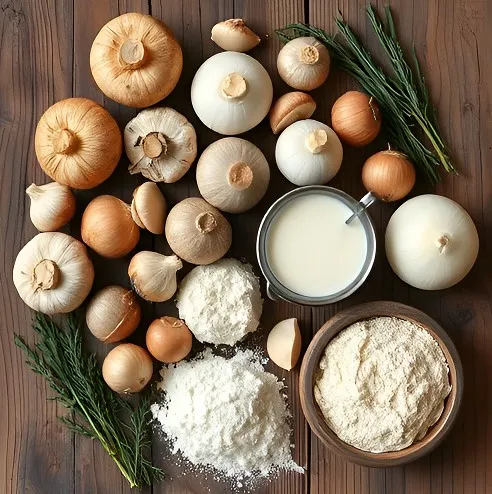
Complementary Side Dishes and Main Course Pairings
While the soup can stand as a comforting starter, it also pairs well with a range of dishes to form a complete meal. A grilled cheese sandwich with a perfectly toasted exterior and melty interior is a classic match. A crisp salad, lightly dressed, can add a refreshing counterpoint, while a tender piece of baked chicken can round out a hearty dinner. The versatility of golden mushroom soup means you can experiment with a variety of sides—each complementing the soup in its own unique way. Whether you’re hosting a casual luncheon or a cozy dinner party, these pairings turn every meal into a memorable experience.
Beyond the Bowl: Using Soup as a Base
An unexpected and creative way to use your golden mushroom soup is as a base for other culinary adventures. Leftovers can easily be transformed into a luxurious sauce for pasta, a comforting casserole filling, or even a savory accompaniment to roasted meats like chicken or pork. This adaptability allows you to stretch your efforts further, ensuring that nothing goes to waste while maintaining gourmet quality across your dishes.
The Nutritional Angle: More Than Just Comfort
The Health Benefits of Mushrooms
Mushrooms are nutritional powerhouses that offer a host of benefits. They are naturally low in calories and fat yet rich in essential vitamins, particularly those in the B group, along with minerals like selenium and potassium. Their antioxidant properties help to fight oxidative stress, making them not only a treat for your taste buds but also an ally in promoting overall wellness. By building your soup around these humble fungi, you’re incorporating a variety of nutritional benefits in a delicious package.
A Closer Look at Calories and Macronutrients
While the specific nutritional profile of your golden mushroom soup will depend on the ingredients you use, it generally provides a balanced mix of macronutrients. The creamy component contributes to a rich flavor and moderate fat content, while the broth delivers hydration and essential minerals. When combined with fiber-rich mushrooms and the natural sweetness of properly cooked onions and garlic, each serving stands as a satisfying meal that nourishes both body and soul. If you’re watching your calorie intake, consider using lighter dairy options or increasing the mushroom-to-cream ratio for a healthier twist.
Tips for a Lighter Yet Flavorful Bowl
For those looking to enjoy indulgence without a heavy aftertaste, there are easy modifications you can incorporate. Use plant-based milk or cashew cream to cut down on saturated fats while still enjoying that wonderful creaminess. Opt for low-sodium broth options or even homemade stock with fresh vegetables, where you control the salt level. Finally, load up on extra mushrooms, which naturally impart an intense flavor, so you can reduce the amount of fat needed to make your roux. These tips ensure that your golden mushroom soup remains a nourishing, satisfying option that doesn’t compromise on taste.
In Conclusion: Embrace the Comfort of Every Spoonful
Golden mushroom soup is more than just a meal—it’s an experience that bridges the gap between rustic family tradition and elegant, modern comfort food. From its humble origins to the myriad ways you can customize and perfect it, this dish encapsulates pure culinary delight in every bowl. Whether you’re cooking on a chilly evening to wind down after a long day or impressing guests with your culinary prowess, this soup promises warmth, flavor, and a touch of gourmet magic.
